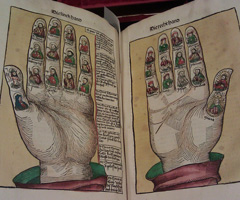UMBC Goes Medieval
As a child, Lauren Bucca loved reading fictional books about medieval times. As she got older, she devoured historical books on the period, exploring a world populated by real events and people.
So when she came to UMBC, Bucca decided to major in English to study more of the literature from her favorite period. Last fall, at the start of Bucca’s junior year, a new opportunity opened up: UMBC began offering a minor in medieval and early modern studies. Bucca, of course, signed up.
“It complements my English major very well because I can have a more focused education by studying the period I like best,” she said. “It’s been fascinating to learn how history is interwoven with literature.”
This interdisciplinary minor is a natural complement to UMBC’s course offerings, said Kathryn McKinley, associate professor of English and the program’s director. “Faculty members in these periods have collaborated for a long time,” she said. “This minor is a way of pooling resources for students and enhancing and strengthening their path of study.”
“In the arts, humanities and social sciences, we encourage students to take a multi-disciplinary approach to their studies because it deepens their understanding of a topic,” said John Jeffries, dean of the college of arts, humanities and social sciences. “This new minor allows students to explore this fascinating and important period from a variety of perspectives.”
“Medieval and early modern studies is an internationally established discipline,” and McKinley said. “UMBC is uniquely situated to have access to archival materials related to the subject.” Just twenty minutes to the north, the Walters Art Museum has one of the largest collections of medieval art and books of hours in the country, and the Folger Shakespeare Library in Washington, D.C., is an invaluable source of material for Shakespeare scholars. “Universities do not always have such outstanding regional resources,” she said.
McKinley recently took advantage of these resources by taking students in her Medieval Dream Visions course, an upper level English course, to the Walters to view medieval manuscripts. “I loved hearing Mr. Will Noel [curator of manuscripts and rare books at the Walters] discuss the manuscripts,” wrote Bucca in response to the trip. “It was incredible to see how meticulously the words were drawn on the pages and the illuminations that were copied from one manuscript to the other.”
The 6-course, 18-credit medieval and early modern studies minor requires students to take two English courses, two history courses and two courses in a discipline of their choice, which might include art, music, modern languages and linguistics, or Asian studies.
Meeting the requirements was not a challenge for Elizabeth Forney ’14, English. “When I signed up for the minor, I had already taken many of the classes required,” she said. “I have yet to take the history classes required but I look forward to them.”
For Forney, and many other students, a minor in medieval and early modern studies is the first step toward more intensive study of the period. “I plan on concentrating on the medieval period in graduate school,” Forney said. “Deciding to take the minor just made sense.” She plans to focus on medieval literature in graduate school and eventually teach high school English and do research.
McKinley said that many students find themselves fascinated with the period. “It’s so distant from modern culture,” she explained. “Students enjoy studying a period in which, for example, genres are much more fluid and alchemy was taken seriously.” She said that courses included in the minor, such as Images of Joan of Arc (ENGL 345) and Art and Society in the Renaissance (HIST 358), are already popular offerings from the departments, and that more courses that fit with the minor are being discussed.
The first medieval and early modern studies minors are expected to graduate in Spring 2012.
(3/13/12)

